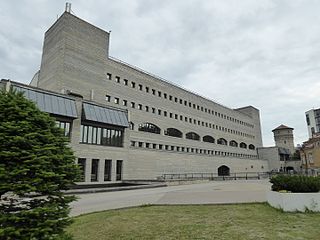
Jaan Kross was an Estonian writer. He was nominated several times for the Nobel Prize in Literature during the early 1990s.
The Estonian resistance movement was an underground movement to resist the occupation of Estonia by Nazi Germany, 1941–1944 during World War II. Due to the unusually benign measures implemented in Estonia by the German occupation authorities, especially in contrast to the preceding harsh Soviet occupation of Estonia (1940–1941), the movement was slower to develop effective tactics on a wide scale than in other occupied countries.

Peeter Sauter is an Estonian author.

Der Giftpilz is a children's book published by Julius Streicher in 1938. The title is German for "the poisonous mushroom/toadstool". The book was intended as anti-Semitic propaganda. The text is by Ernst Hiemer, with illustrations by Philipp Rupprecht ; the title alludes to how, just as it is difficult to tell a poisonous mushroom from an edible mushroom, it is difficult to tell a Jew apart from a Gentile. The book wants to "warn" German children about the dangers allegedly posed by Jews to them personally, and to German society in general.
Tõnu Õnnepalu, also known by the pen names Emil Tode and Anton Nigov, is an Estonian poet, author and translator.
Eesti Ekspress was the first politically independent newspaper in the Estonian Soviet Socialist Republic during the Soviet control of Estonia. In March 2010 the paper was restarted as a magazine.

Estophilia refers to the ideas and activities of people not of Estonian descent who are sympathetic to or interested in Estonian language, Estonian literature or Estonian culture, the history of Estonia and Estonia in general. Such people are known as Estophiles. The opposite of Estophilia is Estophobia.
Arsti ramat nende juhhatamisseks kes tahtwad többed ärraarwada ning parrandada was the first medical manual written in Estonian and is also regarded as the beginning of Estonian popular-scientific literature. It was compiled by Peter Ernst Wilde, translated by August Wilhelm Hupel and printed in 1771. It can be viewed as a continuation or a collection of their earlier work, the Lühhike öppetus.
Estonian literature is literature written in the Estonian language The domination of Estonia after the Northern Crusades, from the 13th century to 1918 by Germany, Sweden, and Russia resulted in few early written literary works in the Estonian language. The oldest records of written Estonian date from the 13th century. Originates Livoniae in Chronicle of Henry of Livonia contains Estonian place names, words and fragments of sentences. The Liber Census Daniae (1241) contains Estonian place and family names. The earliest extant samples of connected Estonian are the so-called Kullamaa prayers dating from 1524 and 1528. The first known printed book is a bilingual German-Estonian translation of the Lutheran catechism by S.Wanradt and J. Koell (1535). For the use of priests an Estonian grammar was printed in German in 1637. The New Testament was translated into southern Estonian in 1686. The two dialects were united by Anton Thor Helle in a form based on northern Estonian. Writings in Estonian became more significant in the 19th century during the Estophile Enlightenment Period (1750–1840).

The National Library of Estonia is a national public institution in Estonia, which operates pursuant to the National Library of Estonia Act. It was established as the parliamentary library of Estonia on December 21, 1918.
Since 1991 Estonia has changed from being a former Soviet republic to a member of the European Union and the European Monetary Union, making a rapid transformation in several fields, including the media, which is a vibrant and competitive sector. For many years Estonia has been among the top ten in Reporters Without Borders’(RSF) Press Freedom Index. In 2017 it has been ranked 12th out of 180 countries by RSF while Freedom House assigned Estonia’s press freedom a score of 16/100. A cross-media landscape that embraces traditional media as well as the Internet and digital media characterises the contemporary media system in Estonia.

Estonia–India relations refers to the bilateral diplomatic relations between Estonia and India. India first recognised Estonia on 22 September 1921 when the former had just acquired membership in the League of Nations. India re-recognised Estonia on 9 September 1991 and diplomatic relations were established on 2 December of the same year in Helsinki. Estonia is represented in India by its embassy in New Delhi and its honorary consulate in Mumbai. India is represented in Estonia through its embassy in Helsinki (Finland) and through an honorary consulate in Tallinn.
The Letter of 40 intellectuals, also The letter of 40, originally A public letter from Estonian SSR was a public letter dated October 28, 1980 and posted a week later, in which 40 intellectuals attempted to defend the Estonian language and expressed their protest against the recklessness of the Republic-level government in dealing with youth protests that were sparked a week earlier due to the banning of a public performance of the band Propeller. The real reasons were much more deep-seated, and had to do primarily with the Russification policies of the Kremlin in occupied Estonia.
Tarto maa rahva Näddali-Leht was a newspaper published in Estonia in 1806.

Kuningamäe is a village in Põltsamaa Parish, Jõgeva County, Estonia. It is located just west of the town of Põltsamaa. Kuningamäe has a populstion of 84.
The Japanese haiku has been adopted in various languages other than Japanese.
Science fiction and fantasy in Estonia is largely a product of the current post-Soviet era. Although somewhat earlier authors, like Eiv Eloon and Tiit Tarlap, do exist. Eesti Ulmeühing is an organization for print science fiction in Estonia that puts out an award called Stalker for the Andrei Tarkovsky film Stalker that was largely shot in Estonia.
Kätlin Kaldmaa is an Estonian freelance writer, poet, translator and literary critic.

Tallinn is the capital and largest city of Estonia. It is on the northern coast of the country, on the shore of the Gulf of Finland in Harju County. From the 13th century until 1918, the city was known as Reval. Tallinn occupies an area of 159.2 km2 (61.5 sq mi) and has a population of 440,776.
The Slavonic and East European Review, the journal of the School of Slavonic and East European Studies (SSEES) at University College London, is an international peer-reviewed multidisciplinary academic journal in the fields of social sciences and humanities founded in 1922 by Bernard Pares, Robert William Seton-Watson and Harold Williams (SSEES) and dedicated to Slavonic and East European Studies published quarterly by Maney Publishing for the Modern Humanities Research Association on behalf of SSEES. Its current general editors are Robin Aizlewood (SSEES) and Martyn Rady (SSEES). The journal can be accessed oline via IngentaConnect.











